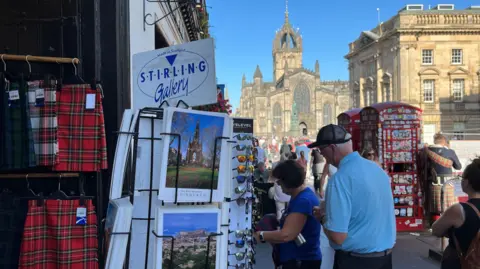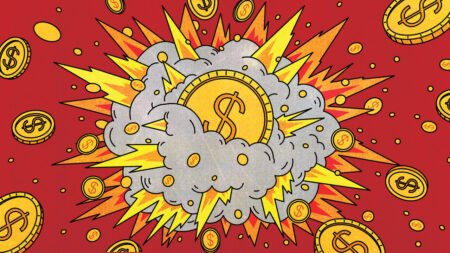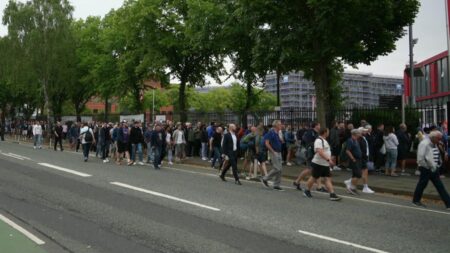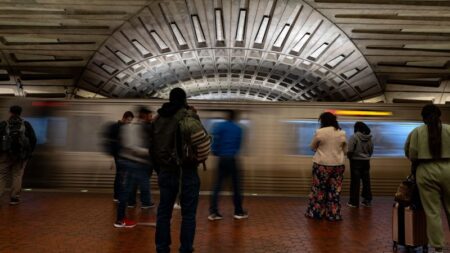Edinburgh’s Royal Mile, steeped in history and tradition, attracts around five million tourists annually. This iconic stretch of the city, which encapsulates four streets running through the picturesque Old Town, showcases landmarks like the historic Edinburgh Castle, the Palace of Holyroodhouse, and the Scottish Parliament. However, beneath its charm lies a growing concern—with an overwhelming increase in the number of tourists and the accompanying proliferation of gift shops, local residents are beginning to voice their discontent regarding overtourism.
In a recent revelation by BBC Scotland News, it was noted that the Royal Mile boasts a staggering 72 tourist shops, offering a plethora of Scotland-themed memorabilia ranging from traditional kilts to quirky Highland cow fridge magnets. While these shops contribute significantly to Edinburgh’s economy—supporting over 40,000 jobs—the dense clustering of similar stores is seen by many locals as a symptom of the challenges brought forth by mass tourism.
Many of these gift shops are operated by just three main businesses, leading to a somewhat monotonous shopping experience for visitors. Notably, among these establishments, two shops specialize solely in Christmas-related merchandise. Alongside this, the Royal Mile is not short of cafes, restaurants, bars, and specialty shops like jewelers and kilt retailers, which adds to the bustling commercial atmosphere. However, as commercial areas evolve, they risk overshadowing the local community, which is feeling increasingly squeezed.
Local residents, like 77-year-old Jimmy Robertson, share firsthand experiences about the changing dynamics of their neighborhood. Having lived on the Canongate, a street at the base of the Royal Mile, since birth, he recalls a once-thriving community filled with essential shops like grocers and butchers—now replaced by stores catering to tourists. The evolving nature of the Royal Mile began in the 1980s, leading Jimmy to assert that while he appreciates tourism, the current state raises concerns about the impact on local livelihoods and everyday life.
Hanna Wesemann, another local resident, highlights the challenges faced by families trying to thrive in an area overtaken by tourist-centric businesses. With a steep decline in the number of pupils at Royal Mile Primary School, fewer families are choosing to reside in the Old Town due to the environment shaped by tourism and associated anti-social behavior from some visitors. Residential areas that once catered to community needs now feel dictated by transient tourist traffic.
The appeal of Edinburgh has grown steadily, particularly among international visitors—recent statistics indicate that the city has attracted one million more international tourists yearly compared to a decade ago. Combined with domestic visitors, the total overnight stays reached nearly five million in 2023. The effects of tourism are pervasive, altering the residential landscape, increasing property rentals, and leading to numerous homes being converted into holiday lets. In fact, over the last decade, the number of Airbnb listings surged from 1,900 to nearly 9,000, a trend that has raised alarms among locals regarding the availability and affordability of housing.
Despite this influx, Edinburgh’s tourism sector plays a critical role in the economy. The city’s vibrant festivals and events attract visitors year-round, generating approximately £435 in spending per overnight visitor, which contributes significantly to countless businesses, from hospitality to transportation. However, concerns about the quality of life for residents have prompted city council members and business owners alike to call for balanced development strategies that take community needs into account.
Council leader Jane Meagher underscores the local authority’s commitment to maintaining a clean and welcoming environment for both residents and visitors. While the challenges posed by anti-social behavior, particularly in tourist-heavy areas, are acknowledged, Meagher insists on the importance of embracing tourism for economic vitality while ensuring the social fabric of the community does not unravel.
As Edinburgh prepares to introduce a tourist tax—anticipated to generate an estimated £50 million annually for infrastructure improvements—there’s a blend of optimism and caution among residents. While some see it as a necessary step to sustain both the tourism sector and the local community’s needs, others question whether it will be sufficient to address the escalating pressures resulting from tourism.
In summary, the Royal Mile encapsulates the dual-edged nature of tourism, fostering economic growth yet creating tension within the local community. As Edinburgh stands on the verge of significant changes in its tourism management, the hope remains that the city’s rich heritage can coexist with the influx of visitors, providing a sustainable path forward for both locals and tourists alike.











